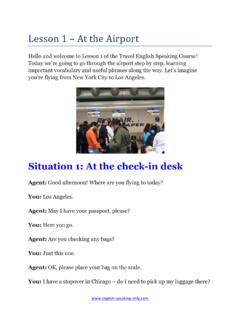Transcription of Survival, Evasion, Resistance and Escape (SERE) Training
1 survival , evasion , Resistance and Escape (SERE) Training : Reducing the Risk to Soldier and Country Introduction Imagine flying a mission over enemy-controlled territory when your aircraft malfunctions and you determine the only viable course of action is to land immediately. While the processes you use to make that determination . analyzing aircraft limitations and executing the necessary emergency procedures are nearly automatic at this point, they are only designed to get you, your crew and the aircraft to the ground safely. Are you equipped with the skills to friendly control. The Level C Training is the and knowledge necessary to deal with what faces designation the Joint Personnel Recovery Agency you once your aircraft and crew are safely on the gives experiential SERE Training for populations ground?
2 What are the 5s and 9s that will help you whose duties place them at a high risk of isolation. survive this isolating event and return you to friendly Most graduates refer to it as, The best Training I. control with honor? never want to do again! . With few exceptions, as personnel performing duties that place them at high risk of isolation SERE Training as Risk Mitigation (personnel who haven't attended SERE Training ) it is The value of Training is often measured by the likely your understanding of policy regarding what likelihood the skill or knowledge will be required, to do during an isolating event and ability to apply which is usually based on historical precedent.
3 This is the tactics, techniques and procedures (TTP) to act where proponents of SERE Training bristle a bit. Not in accordance with that policy is not to the level set unlike aircraft EPs or even the overarching mission forth in current joint policy and Army regulations. of the Army, if you get right down to it the SERE. skillset is one we hope our graduates never have to To provide the appropriate level of Training for validate through real-world use. Collecting data that aviation personnel, the Army integrated survival , correlates SERE Training to real-world application is evasion , Resistance and Escape (SERE) Level C. also difficult, as the lines blur between what qualifies Training , is a 21-day, once-in-a-career opportunity as an isolating event and what was simply a bad day to learn the limits and emergency procedures (EP).
4 At the office for a service member whose mission associated with an isolating event and returning was compromised in some way. to conduct themselves in captivity so as not to compromise the mission, their fellow captives and their own honor. In 20 publicized incidents since 2001, a total of 74 NATO personnel have been held captive by a combination of state and non-state forces. While these captivity events begin at the tactical level . with service members being captured largely while executing their missions the implications and potential consequences reach far beyond that to the strategic and diplomatic levels, where individuals unwittingly serve as leverage to affect policy between the captor group/nation and The Evolution of the SERE Requirement for Army Aviators With Operation Enduring Freedom (OEF) and Operation Iraqi Freedom (OIF) both ongoing and instances of non-Army Special Operations Forces (ARSOF)
5 Being isolated and held captive, Army leaders determined replacing the existing SERE Level B with SERE-C was the most responsible approach to Training and deploying all combat aviators. In 2007, when the Army SERE school graduated its first SERE-C class, combat aircrews were required by Army Regulation (AR) 350-1 to successfully complete SERE-C before assuming duties that placed them at high risk of isolation. Ostensibly, this would mean all aircrews would attend SERE school before deploying. While that sounds good in theory, it's not the most practical plan due to all the Training requirements unit commanders have to accomplish We need to ask the same questions regarding every year, let alone in preparation for deployment.
6 SERE that we use to determine and mitigate any The most feasible solution was to stem the flow of other risks for aircrews: non-SERE qualified personnel into the units in the 1. What is the likelihood that this aircrew will first place. To accomplish this, Army Aviation encounter conditions that could result in an Center of Excellence (USAACE) personnel created isolating event? 2. How catastrophic will the impact be on the aircrew and mission if the isolated personnel are unable to apply SERE skillsets either on evasion movement or in captivity? Lacking the ability to predict with any certainty the answer to the first question, the most responsible approach is to ensure all aircrews who are assigned missions that place them at high risk of isolation are provided the Training necessary to survive that isolating event, successfully evade detection/recognition by hostile forces, and.
7 Barring successful evasion understand how 2. successful recovery, with Resistance to enemy exploitation being necessary only if evasion and recovery are not possible or fail. Essentially (and ideally), if our graduates are able to successfully apply their survival and evasion Training , they will never need the Resistance and Escape Training we also provide. With a nod again to EP Training , the Army is clearly doing what is necessary to properly prepare high-risk personnel for the possibility of captivity. While all personnel are required to complete Level A SERE (usually computer based Training (CBT)). and at-risk briefings (high risk of isolation (HRI) or moderate risk for isolation (MRI)) as theater entry requirements, briefings and lectures cannot achieve the proficiency levels practical application does.
8 Through experiential Training exercises, Resistance Training provides SERE-C graduates with the ability to identify their captor group; understand their rights and responsibilities within the context of that environment; identify the captor's goals and limitations; and to choose a Resistance strategy . including Escape planning and execution that thwarts the captor's exploitation efforts while and integrated SERE-C Training at Fort Rucker as minimizing poor treatment and encouraging part of the pipeline for future aviators. An update good treatment. Students are allowed to test to AR 350-1 was made in August 2014, requiring their application of Resistance TTP in a controlled aviation-branched officers to complete SERE-C prior environment to gain confidence and reduce the to beginning flight school.
9 This change reduced likelihood they will be unwittingly used as leverage the non-rated crewmember requirement to highly to force a concession by the to the captor encourage to attend. nation/group. In total, 21 days of Training once in an aircrew So What? member's career is arguably the best investment Mention SERE school to anyone who has heard of leaders can make in the highly trained warfighters it, and the context of the conversation will likely lean we send up against increasingly complex and heavily toward the captivity-based scenarios we run capable enemies. This is going to become with our students. While understandable for many increasingly true as the Army transitions into large- reasons, none of which that will be discussed here, scale combat operations against a peer or near-peer captivity and Resistance Training only accounts for adversary, likely resulting in much longer evasion half of the SERE school's Training time.
10 Scenarios as well as captivity in the hands of a SERE-C graduates spend about 10 Training days sophisticated, motivated and well-trained focusing on survival skills and how to adapt those governmental force. skills to support successful evasion and recovery efforts, evasion movement techniques, as well as Stefanie Harris how to break contact from enemy forces using SERE Course Manager personal weapons, and how to negotiate barriers to evasion . Fundamentals such as evasion planning, land navigation, and communication and reporting are also reinforced. The primary goal of SERE Training is to prepare personnel for extended evasion and 3. Controlling the Airfield Risk in Combined Arms Operations Forward Operating Base (FOB) Shank proved Army airfield management services inability to effectively manage airfields in 2012 when a C-17 ran 700 feet off the runway during icy conditions.












